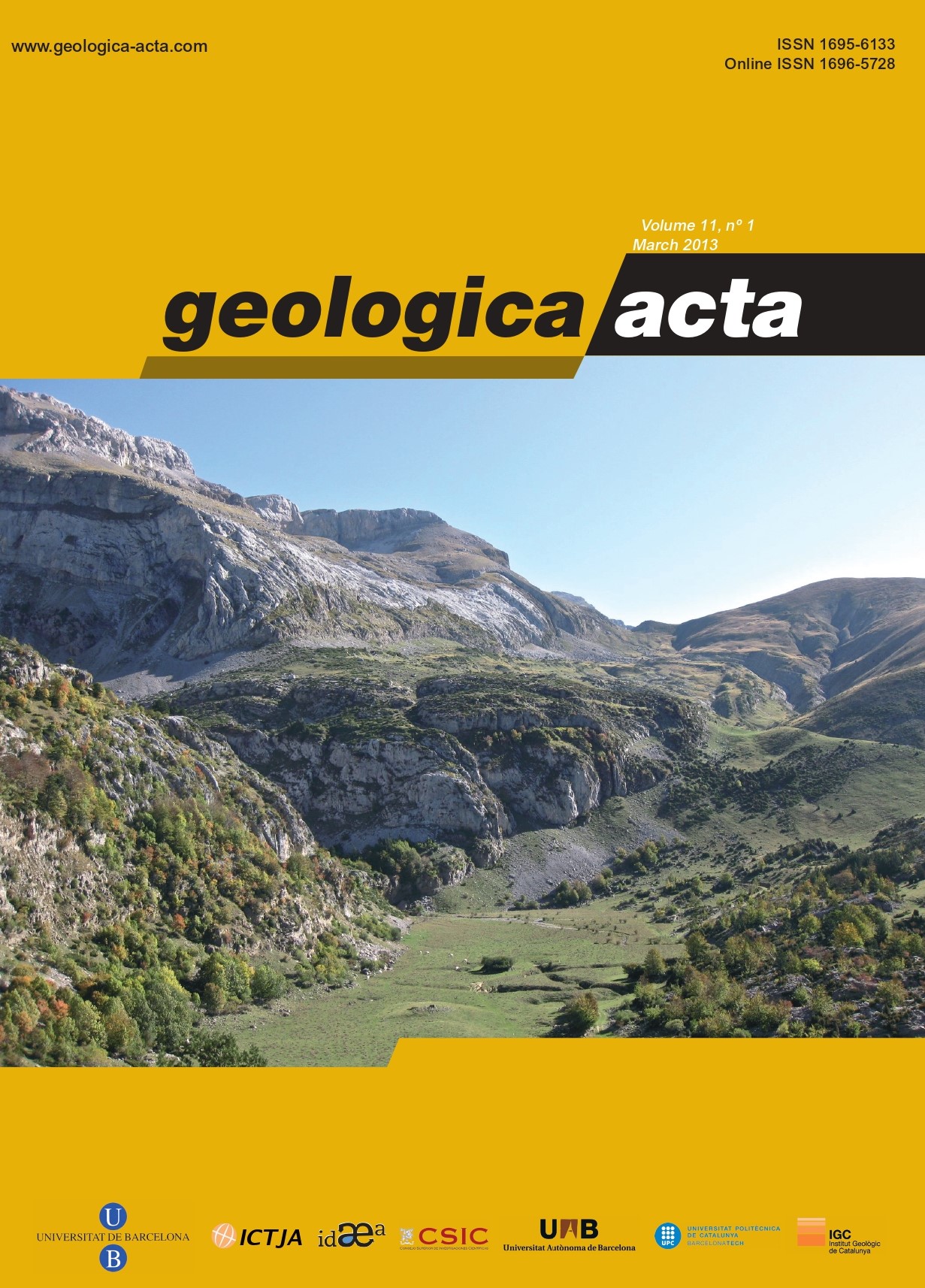Modern and late Holocene foraminiferal record of restricted environmental conditions in the Albufeira Lagoon, SW Portugal
DOI:
https://doi.org/10.1344/105.000001754Keywords:
Benthic foraminifera, Coastal lagoon, Late Holocene, Environmental evolution, SW PortugalAbstract
Benthic foraminifera from twenty stations sampled twice were analyzed in order to examine the environmental conditions of the Albufeira coastal lagoon. Foraminiferal assemblages show an increase in the abundance, species diversity and allochthonous content seaward. Three zones have been defined: the inner and more restricted area of the lagoon where the main species are the euryhaline Ammonia tepida and Haynesina germanica; these two species together with Bulimina gibba and Brizalina britannica dominated the middle area; and, finally, in the mouth and marine- influenced back-barrier area the assemblages are made up of brackish and marine species such as A. tepida, Cribroelphidium williamsoni, Cibicides lobatulus and H. germanica. Additionally, samples from three cores were also examined. Sedimentological and micropalaeontological contents represent the last 2500 years of environmental evolution of the lagoon. Foraminiferal assemblages are not very abundant and they are dominated by H. germanica, A. tepida and Jadammina macrescens indicating very restricted conditions through time. In a regional context, and during the Late Holocene, after the development of a detrital barrier circa 5.5 cal yr BP, eustasy is considered to be a minor environmental control of the barrier-lagoonal system dynamics. Instead, environmental conditions were forced by local factors, such as frequency and duration of lagoon-ocean water exchanges, induced by both natural and artificial changes in the permeability of the sand-barrier.
References
Alve, E., Murray, J.W., 2001. Temporal variability in vertical distributions of live (stained) intertidal foraminifera, southern England. Journal of Foraminiferal Research, 31, 12-24.
Bao, R., Freitas, M.C., Andrade, C., 1999. Separating eustatic from local environmental effects: a late-Holocene record of coastal change in Albufeira Lagoon, Portugal. The Holocene, 9, 341-352.
Cearreta, A., Alday, M., Freitas, M.C., Andrade, C., Cruces, A., 2002. Modern foraminiferal record of alternating open and restricted environmental conditions in the Santo André lagoon, SW Portugal. Hydrobiologia, 475-476, 21-27.
Cearreta, A., Alday, M., Freitas, M.C., Andrade, C., 2007. Postglacial foraminiferal record and palaeoenvironmental evolution of the Melides lagoon (SW Portugal): towards a regional model following eustatic sea-level rise and sandy barrier formation. Journal of Foraminiferal Research, 37, 125-135.
de Rijk, S., Troelstra, S.R., 1997. Salt marsh foraminifera from the Great Marshes, Massachusetts: environmental controls.
Palaeogeography, Palaeoclimatology, Palaeoecology, 130, 81-112.
Freitas, M.C., Andrade, C., 1994. Tidal inlet evolution and hydraulic characteristics at Albufeira lagoon. In: Soares de Carvalho, G., Veloso Gomes, F. (eds.). Proceedings of Littoral ’94. Lisbon, EUROCOAST Portugal, 1, 257-271.
Freitas, M.C., Andrade, C., Cruces, A., 2010. Heavy metals in sediments of lagoonal systems from the southwestern coast of mainland Portugal. In: Neiva, J.M., Ribeiro, A., Mendes Victor, L., Noronha, F., Ramalho, M. (eds.). Ciências Geológicas – Ensino e Investigação e sua História. Geologia e Ambiente. Publicação Comemorativa do “Ano Internacional do Planeta Terra”, Associação Portuguesa de Geólogos-Sociedade Geológica de Portugal, 2(II), 207-218.
Freitas, M.C., Cachão, M., Fonseca, L.C., Caroça, C., Carvalho, A.M.G., 1994. Unusual co-occurrence of Serpulids and Bryozoa in a lagoonal system (Albufeira coastal lagoon - Portugal). Gaia, 8, 39-46.
Friedman, G.M., Sanders, J.E., 1978. Principles of Sedimentology. New York, John Wiley & Sons, 792pp.
Jorissen, F.J., de Stigter, H.C., Widmark, J.G.V., 1995. A conceptual model explaining benthic foraminiferal microhabits. Marine Micropaleontology, 26, 3-15.
Martins, M.V.A., Gomes, V.R.D., 2004. Foraminíferos da margem continental NW ibérica: sistemática, ecologia e distribuição. Aveiro, Celso Gomes, 377pp.
Murray, J.W., 1979. British Nearshore Foraminiferids. Synopsis of the British Fauna (New Series) 16. London, Academic Press, 68pp.
Murray, J.W., 2006. Ecology and Applications of Benthic Foraminifera. Cambridge, Cambridge University Press, 440pp.
Patterson, R.T., Hutchinson, I., Guilbault, J.-P., Clague, J.J., 2000. A comparison of the vertical zonation of diatom, foraminifera and macrophyte assemblages in a coastal marsh: implications for greater paleo-sea level resolution. Micropaleontology, 46, 229-244.
Queiroz, P.F., Mateus, J.E., 1994. Preliminary palynological investigation on the Holocene deposits of Lagoa de Albufeira
and Lagoa de Melides, Alentejo (Portugal). Revista de Biologia, 15, 15-27.
Rogers, M.J., 1976. An evaluation of an index of affinity for comparing assemblages, in particular of foraminifera. Palaeontology, 19, 503-515.
Sen Gupta, B.K., 1999. Introduction to modern foraminifera. In: Sen Gupta, B.K. (ed.). Modern Foraminifera. Kluwer Academic Publisher, 3-7.
Sen Gupta, B.K., Machain-Castillo, M.L., 1993. Benthic foraminifera in oxygen-poor habitats. Marine Micropaleontology, 20, 183-201.
Serandrei-Barbero, R., Carbognin, L., Taroni, G., Cova, E., 1999. Distribution of recent benthic foraminifera in the southern
basin of the Venice lagoon (Italy): statistical evaluation of taxa significance. Micropaleontology, 45, 99-111.
Silva, E., 2003. Dissolved oxygen content in the central area of the Albufeira lagoon (SW Portugal). Personal communication.
Walton, W.R., 1952. Techniques for recognition of living foraminifera. Contributions from the Cushman Foundation for Foraminiferal Research, 3, 56-60.
Downloads
Published
Issue
Section
License
Copyright (c) 2023 M. ALDAY, A. CEARRETA, M.C. FREITAS, C. ANDRADE

This work is licensed under a Creative Commons Attribution-ShareAlike 4.0 International License.
Copyright
Geologica Acta is the property of the UB, GEO3BCN, IDAEA and UAB. Geologica Acta must be cited for any partial or full reproduction. Papers are distributed under the Attribution-Share Alike Creative Commons License. This license allows anyone to reproduce and disseminate the content of the journal and even make derivative works crediting authorship and provenance and distributing possible derivative works under the same or an equivalent license.
Author Rights
Authors retain the copyright on their papers and are authorized to post them on their own web pages or institutional repositories. The copyright was retained by the journal from the year 2003 until 2009. In all cases, the complete citation and a link to the Digital Object Identifier (DOI) of the article must be included.
The authors can use excerpts or reproduce illustrations of their papers in other works without prior permission from Geologica Acta provided the source of the paper including the complete citation is fully acknowledged.




